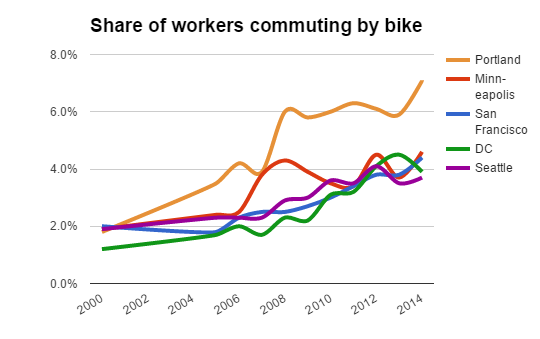
It’s not 2008. But for the first time in seven years, Portland’s bike believers seem to have the wind at their back.
The latest evidence showed up Thursday in new Census Bureau estimates showing that 2014 brought the city to its highest bike-commuting rate on record: 7.2 percent.
The change falls slightly inside the statistical margin of error, so there’s something like a 5 percent chance that the increase is just a statistical anomaly. That said, it’s enough to end a five-year plateau in the city’s estimated bike-commuting rate.
According to the Census, Portland had 23,347 bike commuters last year, give or take about 3,000. That’s a 27 percent jump over the previous year’s estimate of 18,337.
Out of the approximately 14,000 additional commutes by Portland’s workforce last year, about 5,000 happened on bikes.
As biking rates rise, car commuting rates fall
There’s more good news, including for people who drive to work: if this year’s numbers stick around, the growth in biking will correspond to a similar drop in car commuting.
Compared to the 2009-2013 average, Portland’s drive-alone rate edged down from 59 percent to 57.6 percent.
That comes out to 1,900 drive-alone commutes that would be on the road today if not for the shift away from driving and toward biking.
This doesn’t mean that Portland’s streets aren’t getting more congested. They are. Because of job and population growth, Portlanders added 9,000 more drive-alone commutes to the road last year. As we reported last month, Portland will have to do far better than it is currently doing if it’s going to repeat its trick of the 2000s and add jobs without adding congestion.
Advertisement
This brings us to the bad news. Except for biking, low-car commute options haven’t been getting more popular among Portlanders.
Carpooling, though stable recently, has been on a decades-long slide. Walk commuting posted a big jump in 2012 that turns out to have been a blip. Public transit use is also flat, despite a big effort by TriMet to restore bus service that was cut during the recession.
Working at home is edging up, but not rapidly.
For other leading cities, the stall continues
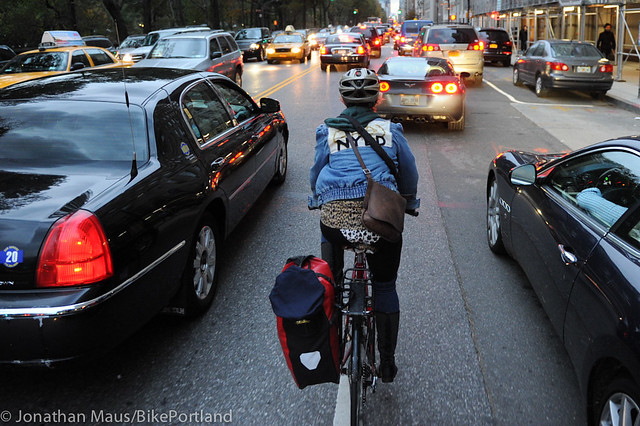
Nationally, bike commuting rates didn’t budge in 2014. The country added 22,000 new bike commuters — but after accounting for growth in the working population, the overall rate stayed flat at 0.62 percent.
In other major biking cities, the news was mixed.
Outside of Portland, some of the best news in today’s Census report comes from San Francisco. After big investments in its bike lane network, that city continues its upward trajectory and just hit 4.4 percent biking, a modern high.
Minneapolis rebounded to 4.6 percent, making a possible slip last year look more like a continued plateau. Seattle’s five-year plateau continues; it saw a 3.7 percent biking rate. New York City, at 1.1 percent, seems to be settling into a post-Bloomberg plateau of its own.
Washington D.C., which doubled its estimated bike-commute rate from 2009 to 2013, slipped back to 3.9 percent after several years of minimal investments by its leaders. Los Angeles, Chicago, Boston, Oakland and Tucson all hit new highs.
The limitations of Census data
The Census measures only journeys to work. It doesn’t include the commutes of full-time students, or travel by people who don’t have jobs. It ignores errands and social or recreational trips, which are about 80 percent of the trips Americans take.
It’s based on a survey, conducted on a rolling basis throughout the year, that asks people the main mode they used to get to work most days last week. If someone uses two modes — driving to a train station, for example — it counts only the one that carried them the most miles.
Despite all of those limitations, the Census is the single most reliable and useful way to measure how a city is doing on biking. Because people are legally required to answer its surveys — a mandate that Republicans in Congress are currently pushing to remove — it has high response rates and low margins of error.
Unlike Portland’s manual bike counts, the Census includes people who work nontraditional shifts — an important biking constituency because the two professions most likely to bike-commute are food-service workers and college educators.
What caused Portland’s latest bike spike?
This new leap in Portland’s estimated bike commuting sets a modern record for the city and the highest bike-commuting rate ever recorded for a U.S. city of more than 200,000 residents.
(In fact, it means that Portland’s bike-commuting rate has exceeded Eugene’s for the first time ever; that city came in at 6.8 percent. Numbers for Corvallis, Oregon’s longtime No. 1 bike-commute city, aren’t out yet.)
What could have caused this jump?
Assuming the figure doesn’t turn out to be a one-year blip — and it might — here are our three top theories.
1) Workforce turnover. It’s important to remember, when we talk about 5,000 of Portland’s additional 14,000 commutes happening on bikes, that we’re talking about both old and new residents. Ten to 20 percent of Portland’s population churns in and out of the city every few years, and people are constantly switching from one mode to another as their life circumstances change. An increase like this is probably driven in part by a natural progression of less bike-oriented people leaving the Portland workforce.
2) Infill apartments. Love them or hate them, Portland issued 5,000 new multifamily building permits in 2012 and 2013, and the boom continues. These apartments, which are almost all being built with far more bike parking than auto parking, account for about three-quarters of all the new homes in Portland in the last few years.
Here’s a strong clue that rising density is changing Portland’s commute habits: people who live in Portland’s suburbs didn’t see a bike spike. Vancouver, Hillsboro, Beaverton and Gresham all have bike-commute rates around 1 percent, which is pretty good by suburban standards. But essentially all of the biking growth in the metro area last year — both over the 2009-2013 average, and over the one-year estimates from 2013 — came from Portland residents.
3) Neighborhood greenways. The bike lanes Portland painted in the 1990s took a few years to pay off. Our network of bike-friendly side streets, mostly installed from 2010 to 2012, may have done the same. I’ve been a skeptic about the ability of neighborhood greenways to lure people out of cars, because I think the network isn’t very intuitive to new users. But that doesn’t mean neighborhood greenways aren’t awesome. They are — especially for commuting. Hopefully I’m totally wrong about their shortcomings.
There are surely other factors at play. We’re eager to hear your thoughts.
Finally, a word of caution: something very important happened at the end of 2014, just as this survey was wrapping up. Gas prices plummeted, and have basically stayed low since.
This year, the drop in gas prices has combined with the decent economy (especially here in Portland) to create a national rebound in driving. It’d be shocking if that isn’t happening in Portland, too.
Today’s news makes Portland, at least for the moment, one of the brightest stars in the national biking movement once again. Harder days for that movement may lie ahead. Let’s savor this achievement — and keep our eyes on the horizon.
Correction 10 am: An earlier version of this post misstated the bike commuting increase in Detroit.


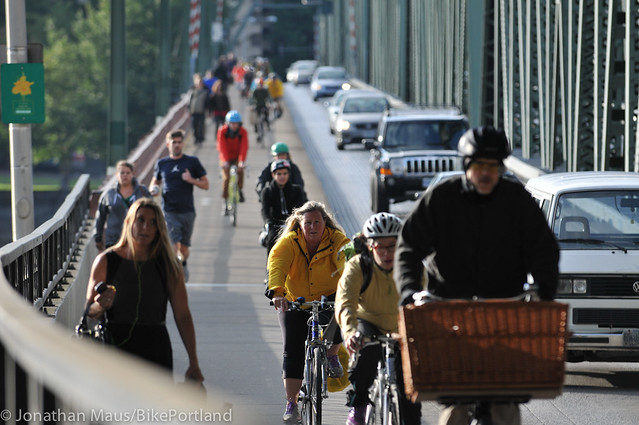
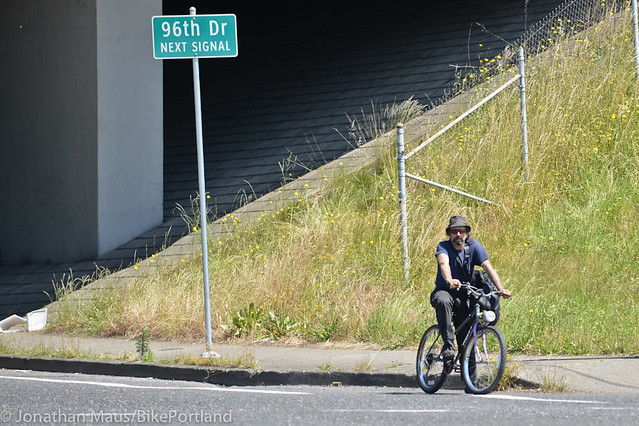
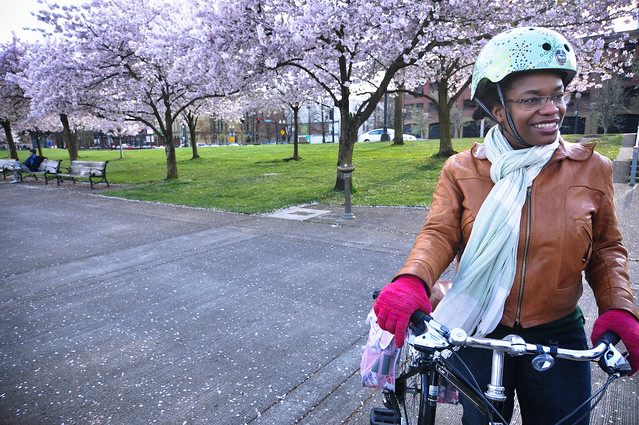
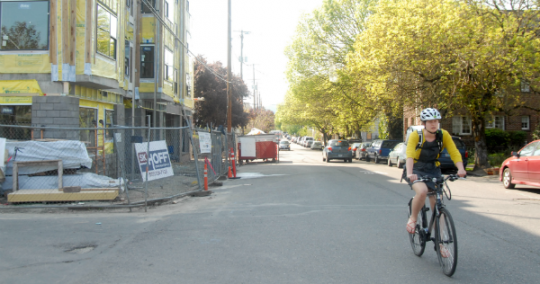

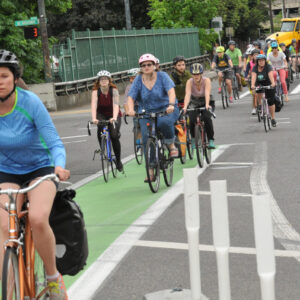
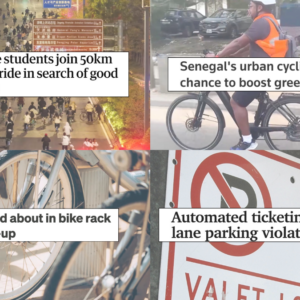
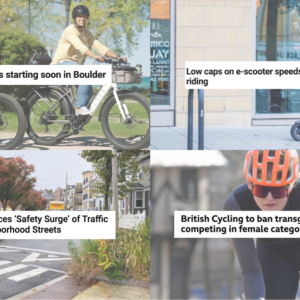
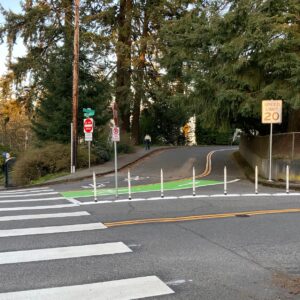
Thanks for reading.
BikePortland has served this community with independent community journalism since 2005. We rely on subscriptions from readers like you to survive. Your financial support is vital in keeping this valuable resource alive and well.
Please subscribe today to strengthen and expand our work.
Theory 1b: job growth in the City of Portland. Portland has historically lagged its suburbs for job growth, but there’s a lot of evidence that this has turned around in recent years. Tech companies in particular have been leasing lots of previously vacant or newly converted office in Downtown, the Pearl and the Central Eastside. These are much more bikeable locations than the growth areas of previous decades, such as the Sunset Corridor or Kruse Way.
I like this theory, because developers are currently betting on the trend of job growth in the Central City continuing. There are couple large office buildings that will be completed next year, and a larger number that are currently going through the City approval process.
This is a good theory. I’m kind of betting on it too. I’m hoping so since that’s the way I’d like to live and would like more options to keep working in Portland and not have to chase out of town work to make money. Generally I do that but I still live in PDX, pay taxes here, and spend all my money in PDX so it’s a net win for the city. Slowly it seems like more and more tech (and other) companies are getting a clue and realize if they want educated, capable, and inspired employees they’ll have to be downtown. There are three medium sized (300+ employees) companies moving in or to very very near ( < 2 miles ) of downtown because their hiring pipelines for their current suburban locations have basically atrophied into non-hires.
It's pretty wild to see the many angles of this happening. 🙂
The company I work for was having problems trying to hire one mid-level PHP developer in an office 24 miles from downtown San Diego (yet still within the city limits). No doubt if they were hiring downtown or mid-city the search wouldn’t have been as difficult. Just a hunch.
I biked to Kruse Way for years. While I can say honestly it was far better than *driving* to Kruse Way every day, I used Barbur as the best available route — and I’d have a hard time recommending that to just anyone.
Well, except during that construction a couple years ago when they shut a lane for a while and gave a little space to bikes. That was kind of pleasant. But aside from then, no.
Michael
Just a note, you can’t make the inference below, implying that the increase in bike share came directly from individuals who previously drove along.
All you can say is that driving alone went down, bike commuting went up, but other modes were not static.
“There’s more good news, including for people who drive to work: if this year’s numbers stick around, the growth in biking will have come straight out of car commuting.”
Agreed, and I didn’t intend that sentence to imply anything about individuals, only the before-and-after sizes of each pie slice. I’ll try to rephrase a bit to make this clearer.
Which ties in with the previous article
http://bikeportland.org/2015/09/16/at-rally-renters-group-calls-for-mandatory-one-year-notice-of-large-rent-hikes-159034
High tech moving in with higher paying jobs that used to be more in the suburbs (Intel Hillsboro, Mentor Graphics, Flir and Xerox in Wilsonville, Nike in Beaverton).
With Oregon not providing enough qualified applicants for these jobs you’re going to get an influx from out of state. Many coming from areas where apartments go for well above $2k a month, so $1200 a month is a good deal to them.
And that’s where the economics of supply and demand come into play with regards to housing. It’s not going to get any better.
I agree, it’s going to continue to get worse, and probably for a long time. It’s good that Portland is finally building lots of apartments. But (as has been reported by BP), Portland went decades building almost no new rental housing, thanks to overly restrictive zoning.
Much of what makes an apartment “affordable” is that it is 10, 20, 30 or more years old. Tens of thousands of units may get built in the coming years, but as New Construction they will command high rents. Thanks to Portland’s 50-year construction gap, it will probably be a very long time before the shortage of more-affordable rental housing eases.
No parking requirements in areas of Portland well served by transit also plays a pretty big role in keeping housing production moving and rents lower than if the tenant had to absorb the cost of minimum parking requirements.
On the development trends side, actually there was more housing production than new residents added in the early 2000s. 2009 was the year that Portland saw the biggest increase of new residents which coincided with the recession and a subsequent five years of tight lending practices which has manifested as very low vacancy rates and rapidly increasing prices.
It would truly be awesome if buildings with no parking had lower rents and rented primarily to people without vehicles. That was the intent of the policy, but I haven’t talked to anyone who makes a credible claim that it’s working. If you have any evidence to the contrary, I’d love to see it.
I believe that building more apartment buildings with little available parking along greenway routes would accelerate increases in bike mode share. I think there is also a very good argument for re-classifying zoning on Greenways to facilitate greater density (e.g. R1 or RH).
I think it’s reasonable to advocate for this idea. However, this could make it harder to add more greenways. Anti-density advocates will start lobbying hard to prevent new greenways being built to prevent the risk of the lots along the corridor being rezoned for higher density.
This could have accomplished, with the least resistance from neighborhoods if the higher density was limited to bikeway crossings. We need, throughout the city, a greenway or protected bikeway minimally every half mile, or ten blocks. In in the flatter, inner neighborhoods even more densely.
The greenway crossings, like 16th and Salmon or even 32nd and NE Mason could be zoned ” mixed use dispersed.”. This would allow for corner stores with apartments.
I also think that 20 mph greenways should be allowed extra ADUs. The city could go so far as to rent out street space for fully contained Tiny Houses for low incomes with water delivery contracts included.
We also need to divert traffic every 2-5 blocks throughout the grid — consistently push back to arterials to minimize cut-through and crossing traffic.
“I believe that building more apartment buildings with little available parking along greenway routes would accelerate increases in bike mode share. …” soren
Increase biking to what percent mode share from where it is presently, in areas where possession of a car and opportunity to park it is present? The range of people for whom biking is a reasonable option, is not something easily established. Likely for a lot of people, this situation will result in them having to conclude that for them, housing with little available parking is not a reasonable option.
Great news and great article. Thanks!
“Out of the approximately 14,000 additional commutes by Portland’s workforce last year”
“Portlanders added 23,000 more drive-alone commutes to the road over the same period”
wait, did we switch time periods? when were the 23,000 drive-alone commutes added? they obviously didn’t come from the 14,000 new commutes….
Good question. 14,000 new commutes since last year; 23,000 new drive-alone commutes since the 2009-2013 average. We switched after “compared to the 2009-2013 average.” But yes, this is confusing. I’ll edit.
Now let’s build the much-needed projects in the outer parts of the city and metro area.
One of the things I would like to see in east portland is default reconfiguration of bike lanes to buffered lanes when there is arterial restriping. While buffered bike lanes may not be everyone’s favorite infrastructure, they allocate space for additional improvements (e.g. protected bikeways) when funding becomes available.
Rather than a striped buffer, which creates a no man’s land that often has less traction than bare asphalt, how about we just increase the width of the bike lane? That would still “reserve” space for changing the nature of the bike lane while giving cyclists the option to stay in the field of surveillance of motorists. Those who prefer to ride in the gutter would still be free to do so.
Except then most people think it is just a parking lane.
Yep. The lane on the south end of Naito after it merges in from Arthur has a SMALL buffer. People dropping off their kids at the International School just down the hill would park in the bike lane. When I informed drivers of what they were doing, their excuse was that what they were doing was fine, and that I should ride in the bike lane (meaning the buffer strip that’s about 12 inches wide). Confusing and inconsistent bike facilities contribute to people’s unease about commuting by bike, on both sides of the windshield.
“…Rather than a striped buffer, which creates a no man’s land that often has less traction than bare asphalt, how about we just increase the width of the bike lane? …” b carfree
Wider bike lanes are a much better idea than paint on the street buffers…simpler, cleaner, easier to visually check for hazard avoidance. Instead of a 5′ or 6′ wide bike lane with a 2′ painted buffer, having a 7′ or 8′ wide bike lane would be markedly easier and safer to travel.
It would be interesting to speculate on this increase in Portland cycling as a cause of (or simply something correlating positively to) the increase in bike theft here. Either way, this new data should be used to further pressure the local police and judiciary to improve apprehension, prosecution and meaningful sentencing of bike thieves.
Unfortunately, bike theft seems to be a lagging indicator of bike use; Portland’s bike theft spike didn’t start until its mode share had plateaued. See the second chart on this post: http://bikeportland.org/2015/04/30/portland-crime-plummeted-every-major-category-except-one-142503
so this means we’ll be getting 33% of the transportation funding towards bicycle projects, right?
I am not a statistician, but I think the margin of error the ACS uses is a 90% confidence interval. I like to think of it as “we are 90% confident that the true number lies in the range of the margin of error.” For Portland in 2015, that would “90% confident that the true number” is between 20,387 and 26,307. For 2013, it would be between 15,717 and 20,957. Error bars on the graph can help one visualize this.
That’s correct, which means that for this to be an anomaly, you’d need 2013’s actual figure to be near the very top of the estimated range (something like a 10% chance), and you’d also need 2014’s actual figure to be near the very bottom of the estimated range (also something like a 10% chance). So 10% x 10% = 1 percent probability. I rounded up to 5% for good measure.
I thought ACS results were only meant to be averaged over 5 year periods?
No, though the margins of error are lower if you do average them over five-year periods. In this case, the increase was so large that it’s almost outside even the relatively fat margins of error for one-year data. That’s why we felt safe making a big deal about it.
I say an anomaly in the data. With a rainy day like today bike commuters drop precipitously. Just fair weather patterns could affect this data.
That’s why the Census gathers the data on a rolling basis throughout the year. Though the fact that late 2014 was unusually dry in Portland could be related.
Commuter bike parking outside downtown office buildings is down this week, for some reason. Maybe they all took their fenders for the summer!
WE DID IT
I have always said that greenways are the “gateway for support” for a bike dominant life. We are part of a social movement trying to change an ingrained part of American culture…… The auto commute. Greenways go from your Neighborhood to school in a pleasant way with your family and friends…then you graduate and bike to college or work.
The thought of buying a car? Well, with the wages entry level employees make now with rents? Who can afford it…..so they continue to bike. Hook the entire school and park system up…..which could be done in one administration if we focussed, and we would easily see that rate spike significantly…..a few years down the road.
Greenways are a great gateway (when they work, anyway), but if we want to move past sub-10% levels, we need protected bike lanes on arterials. Most of the places people need to bike to are in business districts that nearly universally lack safe bike infra.
I don’t know. To me there are a dozen things we could put on the wishlist if we were serious about increasing bike mode share. But at the top of my list would be what Roger Geller conceded here not so long ago – making driving more difficult/less attractive:
“Our policy says that we need to make bicycling more attractive than driving for trips three miles or less. We haven’t really done that yet. It’s really easy to drive a car in this city.”
http://bikeportland.org/2014/09/23/panel-ponders-portlands-slide-cycling-superstardom-111205
Replacing car lanes with protected bike lanes would certainly help make driving more difficult. That and charging high prices for car parking.
I absolutely agree. The types of road reconfigurations that occur when protected bikeways are installed on arterials often make driving less attractive.
And it gives drivers a first-person view of great cycling infra. 😉
Most road diets aren’t going to add congestion. Maybe a few seconds sometimes, but maybe on average faster because of fewer crashes due to bozo lane-changing speeders. How rededicating space on arterials helps is by making biking more visible (and inspiring) to folks stuck in cars.
Road reconfiguration often removes parking and parking scarcity has a positive impact on active transport. (There, I said it.)
How about paying the true costs of gasoline? If 190k drive-alone drivers are burning one gallon of fuel every workday, that’s nearly $50M/year for every dollar/gal in fuel tax. I think we’re short about $15/gal, but most 7th graders should be able to make the case for at least $5/gal in taxes.
Even without taxes, drive-alone gasoline is at least $100M/year leaving our economy.
It may be “leaving” our economy, but this is obviously money that people feel is well-spent. If they didn’t, they’d find a different way to get to work.
I agree we should be raising the gas tax while prices are low…
It’s only a deal because we’re practically giving gas away. If it was $10 a gallon, I don’t think you’d see people burning fuel in their cars while they check their texts and wait for their value meals.
Eliminating massive oil subsidies AND actually making oil companies pay taxes would make the price spike quite a bit.
“Replacing car lanes with protected bike lanes would certainly help make driving more difficult. …” herstein
Do you seriously believe people having to drive, will support such an idea? They’re the majority.
Working to create infrastructure that will allow practical biking to be safer and comfortable is a positive idea, possibly one capable of gathering broad appeal. For most people, their road infrastructure priority is for that infrastructure to designed to have driving be less difficult than it is now.
There are people out there who think that transportation is a zero-sum game; that cyclists can only “win” when drivers “lose”. You can see that sentiment in many of the posts in this and other stories.
I believe that cycling can make a lot of progress without making life miserable for drivers, and I’d go further and suggest it’s the only way.
I think, in some ways, the zero-sum attitude serves to make it harder to improve cycling in the city.
“I believe that cycling can make a lot of progress without making life miserable for drivers”
I don’t know about miserable, but
(a) paying their fair share,
(b) switching so that those on bikes have the direct routes and people in cars get to take the long way around,
(c) penalties for hurting someone are proportional to risk, mass, probability, or whatever, just not what we have now.
I think Europe as a whole offers a package much more like the above than what we have. People still drive, but the playing field is much more level and biking is far safer and more common. Or do you disagree?
These are all vague and good-sounding ideas that, sure, I support. None are inherently anti-car or misery inducing.
But what do you mean by “fair share”? I don’t think gas taxes are unfairly low, but if I could, I would raise them today, because I think they are too low for reasons having nothing to do with “fairness”.
I also don’t know what you mean by direct vs. the long way around (well I know in a general sort of way, but the specifics are very important), but I do agree that we need more greenways where speeds are low and bikes are prioritized (Idaho stop, etc.). We have a street classification system in Portland, and I wish the city would put more effort into “enforcing” it, which would entail directing traffic “the long way around”, sort of, in some cases.
As for penalties for injuries, again, it depends on the specifics. I am not vengeful. I agree that from a legal point of view people breaking traffic laws and injuring others do seem to be getting off rather lightly. On the other hand, there are non-judicial penalties (insurance premiums, for example) where penalties may already be added that we may not see. It’s a very complex issue.
I do disagree that cycling is inherently safer in Europe. It is certainly better in some places, and definitely worse in others.
I’m unable to respond to Hello, Kitty’s comment, so I’m responding here instead.
“I don’t think gas taxes are unfairly low.” We are way behind the rest of the world, and even behind ourselves, in raising the gas tax. Gasoline is very heavily subsidized, and non-drivers pay an unfair share of the cost of gas. There are articles out there that spell this out in more detail.
“I also don’t know what you mean by direct vs. the long way around.” I don’t know if you commute by bike a significant distance. Here’s what my route looks like: http://ridewithgps.com/routes/10445229 Take a look at the cue sheet on the left.
“I agree that from a legal point of view people breaking traffic laws and injuring others do seem to be getting off rather lightly.” That is an understatement.
I agree that gas taxes should be raised, but not for reasons of fairness. Calculating the “true cost” of gasoline involves a huge number of assumptions that can radically change your answer. For example, many people add the military costs of our involvement in the middle east, as if we would not have entanglements there if not for oil. In fact, the US does not consume a lot of middle eastern oil, and Oregon almost zero. But oil is fungible you might reply. And so we go down the rabbit hole.
And there is the question of what is fair in a large and complex society. If I am homebound, is it fair that I pay taxes to support road maintenance? Why should I pay school taxes if I will never have children? And so on. The case for raising gas taxes is probably stronger without invoking “fairness”, which is so easily attacked.
I strongly support better biking facilities almost everywhere. But I think to win them, we need better arguments than “not fair”.
We use a lot of Middle Eastern oil – even Iranian oil, just indirectly. It’s used in factories in China to make our plastic products, then in the Chinese trucks to get those products to the ports, and then in the ships and airplanes that bring those products to our ports. Sure, we might not be fueling many of our cars with oil from the middle east, but we still consume more the oil from the middle east than most other countries do.
The reason we went to Iraq wasn’t directly about oil, but it had everything to to do with keeping the US dollar as the currency of commodity trading. How the oil of Iraq was potentially going to be sold was the threat.
All commodities, be it oil or wheat or whatever are traded in the international markets with US dollars (and “we” profit greatly from every single trade). Saddam was threatening to start selling Iraqi oil in Euros. And if that happened and was successful, it would have been financially devastating for the US.
As I said, allocating these costs “fairly” is very difficult because the issue is so complex.
” I’ve been a skeptic about the ability of neighborhood greenways to lure people out of cars, because I think the network isn’t very intuitive to new users.”
–This is true, but my wife and I make extensive use of the network thanks to the free Portland biking pocket map we picked up.
Those pocket maps are great Brad (thanks PBOT). My bike has been my main mode of transport for years and I still carry one when I need to find weird connections to lesser visited parts of town.
Do these numbers include bike thieves riding their stolen bikes to the chop-shop? If so, that could account for the recent jump.
I think another contributing factor would be that traffic congestion has gotten much worse with so many people moving to Portland. I know my bike commute is only about 10 minutes longer than driving by car now and I would rather ride than sit in traffic.
Often my prime time bike commute was faster than car. No traffic and sometimes I get to ride along with a bike school (Like fish school).
Here are some things that would help increase those numbers that the city and state flat-out refuses to do:
Bike lanes on NE 15th, protected bike lanes on MLK, bike lanes on Belmont, Morrison, Burnside, Division, Hawthorne, Alberta, Killingsworth, Ainsworth, Mississippi, Lombard, Cesar Chavez, 11th/12th, etc.
Any time I ask about any of the above streets I get the answer that it’s too “politically difficult,” “would require parking removal” or some other, similarly whiny, answer. Perhaps if the people leading actually had a spine, we could see these numbers double or even triple in the next decade.
At any rate, it’s nice to have more people biking, even if the infrastructure hasn’t caught up with the demand.
And, to the person who called me petulant for wanting safe bike infrastructure – perhaps you haven’t dealt with the most petulant people of them all – PBOT and ODOT.
Here is an actual response they sent in regards to wanting painted crosswalks on our urban highways:
“Once your investigation request is reviewed, about a 16-week wait time, PBOT staff will identify what traffic patterns and collision history exist at the exact location identified and, in response, recommend best next steps. Please note that PBOT does not install painted crosswalks at locations that do not have a significant and documented history of collisions or injuries – near misses do not count toward the summary. If no history is presented to support a painted crosswalk installation then no improvement will be implemented.”
In essence, it will take 16 weeks, and then they will determine that they still won’t paint a crosswalk.
In another email, someone from the city of Portland actually said:
“The city of Portland has a world-class bike infrastructure” and when I pointed out a dozen examples of sub-par or non-existent infrastructure, they said that they “politely disagree” and kept insisting that the city has top-notch infrastructure.
These are just two examples of how the city acts like a child when confronted with their infrastructure issues. Keep in mind that neither person actually rides a bike, nor walks very far, but they insist that nothing is wrong.
Nobody got killed there because not enough people are walking there because they’re afraid that if they did, they would get killed. If a few people did get killed, then the city would install a crosswalk and nobody would use it because that’s where those people got killed. Besides, it takes less time to drive across the street because the lights favor the auto traffic, especially if you’re speeding. Priorities.
I wish the City would get serious about making safe, simple connections between Greenways. My favorite example is Skidmore between N Interstate Ave and NE 7th. If buffered/protected bike lanes were added, the Concord, Michigan and Going greenways would become interconnected with safe crossings of Interstate, Mississippi, Williams, Vancouver, MLK, and 7th. This would provide people on bikes safe and comfortable ways to move between NE and N Portland and access the commercial streets in Kenton, along INterstate, Mississippi, Williams, MLK and Alberta. Combine this with some real safety improvements to 7th and a new bride over I-84 and the whole inner eastside is starting to have some connectivity.
Skidmore definitely could use some help along the stretch you are talking about Max, especially after the recent hit and run. Recently it seems that there has been an uptick in motorists who’d rather honk and yell than make a safe and legal pass around me when I’m riding between Interstate and Vancouver/Williams. I ride like the Oregon Bicycle Manual tells me so I’ve got that going for me.
I suppose my only concern is for the older people who have disabled parking spots along the road who live in houses predating the automobile.
Does anyone (paikiala maybe) how that issue is handled when parking spots go away?
I have really started to dread this part of my route in the afternoon ride home.
“I suppose my only concern is for the older people who have disabled parking spots along the road who live in houses predating the automobile.
Does anyone (paikiala maybe) how that issue is handled when parking spots go away?”
Have them switch houses with someone on a different street who has a garage, but no car. Or, they could park on a perpedicular street and wheel over. Or, they could build a driveway or parking garage.
There are quite a few options.
I think this is facetious, but I can’t quite tell.
some of my comments are very facetious.
There’s no reason, spacing wise, to remove parking for people using mobility devices. Simply narrow the roadway to accommodate their parking.
If that means narrowing the 2 driving lanes down to 1 for a short stretch, I don’t see anything wrong with that, and it would discourage speeding.
Thank you for clarifying your position Ethan.
“switch houses.” Yeah. Real easy for the average homeowner to just “switch houses” with a neighbor.
“build a driveway or parking garage.” Okayyy. Installing a curb cut and driveway is a *major* expensive, time-consuming process requiring permits, compliance with city codes, etc., and it’s probably not even possible on many urban lots. Adding a garage increases those difficulties exponentially.
For the average senior citizen, honestly, it’s going to be a lot more realistic to simply sell.
I’d hate to see the retirees priced out of my neighborhood. They are an important part of the social fabric of the community, not to mention they’ve been around here much longer than I have and deserve some consideration.
Improving conditions for cycling around here is going to take a nuanced approach. I’ll admit to not always being patient enough to come up with one. In the meantime, yay 7%!
“…I suppose my only concern is for the older people who have disabled parking spots along the road who live in houses predating the automobile.
Does anyone (paikiala maybe) how that issue is handled when parking spots go away?” chapman
Some years back, what Beaverton offered to do to help residents along Lombard St when the city converted the curb parking part of the street to a bike lane, is allow them the option of adding parking area in their front yards. Not sure, but the city may even have given some money to homeowners to defray expenses.
Failing has a ramp over I5 and is only about a quarter mile away. Could improvements there substitute for a better Skidmore?
I don’t get it. I read so many negative reports about how there’s been no cycling improvements happening the past couple years in Portland yet we have a spike in people riding. It must have been due to the mild winter and long summer.
It could also be because of all of those ‘Californians’. About 35% of new trips are being done by bike (about 5x higher than ‘native’ rates). So maybe they’re not such awful people after all?
I thought the weather might be a factor as well. We all know that we see quite a few more cage-free people when the weather is mild and dry, so I checked the number of rain-free days in PDX for 2013 and 2014. Interestingly, 2013 had 27 more days of rain than 2014 (206 rain-free days in 2013 vs 179 rain-free days in 2014). Perhaps temperature is more important than wetness, but I’m not sure how to assess that data in a meaningful way.
I like the cohort replacement hypothesis and traffic congestion increases as explanations for the bump. Millennials are far less likely to even have drivers licenses, let alone be car-dependent, than the old folks they are replacing. Also, as the regions population continues to grow and add to motorized congestion, cycling begins to be an alternative worth trying for more people.
I personally prefer it to be chilly. That way I don’t sweat as much 🙂
“…cage-free people…” b carfee
It’s no better to be referring here in such terms, to people that drive, than it is for the oregonlive.com’s cranks to be referring to people that bike as ‘Bike Nuts’. Please knock it off, save it for the bar room.
Great reporting and great news. Has the number of people moving in spiked in 2014/15? It feels like it–probably because of folks down south coming to grips with the drought. p.s…9000 single occupant cars in a single year?–eeeeeeeeeejjhhh. Cough, cough. Thank you, new resident cyclists, from the bottom of my lungs.
The construction of infill mixed-use apartments is a national phenomenon, not just a Portland thing, although it’s possible that it might only lead to an uptick in ridership if coupled with relatively decent bike infrastructure.
Good point. My best counterpoint would be that Portland may be one of the few cities where we have both (a) a small enough and not-dense-enough population for new construction to have a meaningful impact on these numbers, and (b) such a large number of these buildings going in with very little on-site auto parking, which makes them disproportionately attractive to bikey folks.
Why would a building with no parking be disproportionately attractive to bikey folks? I thought the whole problem neighborhoods had with these buildings was that this was not in fact true.
Yes, if you didn’t have a car, I think price (and location) would be your main factors, not lack or presence of a parking spot for your nonexistent car.
Even if a new building has “only” 30% car-free tenants, that’s far higher than the general population, so it would still true that those buildings are disproportionately attractive to such people.
“Why would a building with no parking be disproportionately attractive to bikey folks?”
– Bikey neighbors.
– Lower rent (I’m thinking a certain status, or “option” value comes with the option of renting a parking spot — “what if I *did* buy a car…”)
– Less car access oriented building ground floor
– Sometimes better bike parking
– Sometimes amenities like a Bike Wash
Ted Buehler
Member, Boise Neighborhood Association Land Use and Transportation Committee
“Disproportionately attractive” as in, if you drive your car all the time, it’s going to be pretty annoying to constantly park it in a crowded neighborhood. If you don’t own a car or (as is more often the case with residents these buildings) you own a car but don’t use it frequently, no big deal.
“…you own a car but don’t use it frequently, no big deal.” andersen/bikeportland
Even if housing residents don’t use their car frequently, not having a good place to park it is a big deal. Parking area mandated for housing, not used for parking cars of residents, does not necessarily need to be wasted space. It’s potentially usable for a range of other things, storage for one.
Elsewhere in this discussion, someone suggested using street parking as an area to site tiny houses. Unused to park cars, off-street parking seems a better site for tiny houses.
If the building has little parking you might rent an apartment for $1500 if you have a bike. If you rent a spot in the garage for your car that goes up to $1650. If the building had a lot more parking the spots might get rented out for $50 a month instead of $150, and the cost of construction for the whole building would’ve been higher. So some of those buildings would not have been built, or would have been built with fewer units. Lower housing supply would’ve raised apartment rents for everyone. Parking mandates are affordable housing. Except for cars instead of people.
Portland has one of the lowest vacancy rates in the nation indicating that demand for apartments is exceptionally high here.
I wonder if this increase is in part because people are moving here specifically to bike commute? My family and I moved here from Louisiana to live a car free life, and my husband is now a bike commuter. The biking/walking/transit niche is hopefully attracting people who are looking for a car free/car light lifestyle, which will continue to boost the biking rate.
Welcome, Kelly and family! 🙂 I love to hear this.
I read somewhere that ACS was considering changing their transport-related questions to better capture true mode. Any idea if that’s true, Michael?
As someone who goes virtually everywhere by bike, with maybe a 2% use of Tri-Met, but who no longer commutes to a job at all, I feel like important decision-making data about bike infra is being disregarded. I’d love to see that oversight somehow corrected.
It’s just one of many ways that people not in the “workforce” are discounted.
I’m a stay at home mom, about 33/33/33 between walking, transit and biking, and I feel the same way – discounted, bc I’m not in the workforce.
There was a push within the Census to change the commuting question to let people name more than one mode. Apparently it got shot down within the bureaucracy.
There’s no discussion that I’m aware of, except on advocates’ wish lists, to try to measure trips other than commutes. That’d be a huge undertaking, better pursued (IMO) by the National Household Transportation Survey that happens every five to eight years or so but isn’t big enough to get good data except at the national level.
Any value in the Oregon household activity survey?
http://www.portlandoregon.gov/transportation/article/452524
“In 2011 28 percent of trips by Portlanders were either walking (15 percent) transit (7 percent) or bicycling (6 percent)”
Many of us in the work force are dropped too.
My job requires nearly one ton of gear and equipment and I have had jobs sites all throughout Washington and Oregon (with recent threats of work in Idaho and Montana). As an example this week I had to be in Chehalis WA at 5am for two days and LLoyd Center for 3 days – and it was threatened (but didn’t happen-thankfully) that I might have had to be at both sites on one of those days with work at one and a meeting at the other. It simply is not possible to commute by bicycle for my occupation. Though on very rare occasions I have been able to bike it to work (usually for meetings where I know no actual work is going happen).
However for nearly all my personal errands I use a bicycle. I likely put on more miles on my bicycle than I do in our family car every year, and if my wife and I didn’t go to SF and Seattle every year for her work, I would easily out mile out personal car each year.
But you know, like yourself I don’t count. Even though with errands and rec rides I likely out mile many bicycle commuters too.
If the ACS started tallying and reporting total miles travelled, it would probably look far worse for cycling. Most folks ride very little compared to the amount that motorists drive. Cycling commutes tend to be shorter, many bike commuters do those other 80% of travel by car and even car-free people don’t tend to ride to the coast or mountains with the same frequency as the cagers. (Yes, I know there are people like me who ride 10-20k miles per year, but that’s not exactly typical.)
We probably get better PR out of just counting commute trips than we would by any other measurement, so we shouldn’t press for changes.
I’m less concerned with PR – or with out of town travel – than with data that would help City decision makers think more clearly about safety and accessibility. Around-town errands and visits rarely take me into downtown the way my job used to, so routes like the infamous 20s project are more important to me now than they used to be.
From what people here say, many people who don’t or can’t bike commute to their jobs do use their bikes for other everyday trips. And of course, there are the not-yet-employed (hint: kids) whose transportation data is not collected here.
Great news! I hope.
I’m slightly skeptical, though, since by many other metrics 2014 was just another flatline.
* Hawthorn Bridge counts
* citywide counts
* reports of “bicycling has lost its mojo” that were well founded and had arguments that resonated with the constituency —
http://www.portlandmercury.com/portland/slow-leak/Content?oid=12634954
&
http://bikeportland.org/2014/05/13/something-has-gone-wrong-in-portland-105851
You’d think that if there was an uptick of the magnitude reported by the census that it would have been seen in other counts as well.
So, optimistic datapoint, but, there’s lots of work to be done if we want be certain that bicycle rider numbers will go up to some reasonably high number, like 10%, 15%, 20%. Because there’s plenty of evidence that the quality of bicycling in Portland today is a few notches below where it was in the 2008 era when ridership was still growing dramatically every year.
Roads are in worse shape. More cars. More cars on greenways. Bridges are pretty much at capacity (except Hawthorn/Tilikum), many more agro drivers than 2008, loss of lustre of new facilities, etc.
Ted Buehler
I hear you and share the skepticism, Ted. But Census numbers do capture a bunch of stuff that none of those metrics capture. I will be surprised if next year’s estimate doesn’t tick downward somewhat.
The great recession was associated with a similar spike in mode share and apparently many of those people continued to bike commute.
Congrats also to Minneapolis and San Francisco for creating increases of a comparable magnitude.
Hopefully this will be the beginning of a new positive trend in the leading bicycling metro areas.
Ted Buehler
Sorry,
But the prize for having the most influence on increasing the bicycle share has been (drum roll please) >>>>the weather.
The last few years with a couple of exceptions (most notably Feb 14) has been dry and warm which obviously increases the “ideal” riding season.
Unless this upcoming quarter weather really turns around, 2015 is going to blow the doors off 2014 too.
15% more rainy days in 2014 than 2013, yet bike commutes increased from 5.9% to 7.2%. I think drier weather wasn’t the cause unless there was something special about the pattern of the rainless days in 2014 that increased the likelihood that someone would get on the saddle.
Also, it’s not like the south end of the Willamette Valley gets significantly different weather, so why has Eugene fallen from 10.8% in 2009 to 6.8% in 2014 if weather is the driving (oops) force.
If you look at the historical indexes
https://weatherspark.com/history/31237/2013/Portland-Oregon-United-States
https://weatherspark.com/history/30477/2014/Portland-Oregon-United-
There was significantly less rain May to September in 2014 than 2013. Though 2014 was a wetter winter and fall.
The Dew point in 2014 for the summer months was more contained in the comfort parameters than the summer months for 2013. 2013 was a sweatier summer than 2014 too.
You really don’t think weather has any effect on bicycle ridership? Check the Hawthorne bridge counts on a rainy day over a sunny one. It’s not uncommon to see those numbers drop to half with rain.
If you look at my comment well above where you jumped in, you’ll see that I most certainly do know that ridership in PDX plummets when it’s wet. However, I think the number of days with rain is more relevant to the impact of weather on the fair-weather-rider folks than the total amount of rain that falls. One good four-inch storm has less impact on daily ridership than two weeks of 0.4″ per day, imo.
That’s why I’m cautiously optimistic that 2014’s slight increase in ridership is about more than the weather. 15% fewer dry days while adding measurable numbers of folks riding is good, if unexpected, news. (I am inclined to find most good news unexpected. 🙂 )
We’re aren’t debating “if” weather is an effect, it is. And I even agree with your statement that one big fast event has less effect than many smaller events strung together.
Summer of 2014 was nearly five straight summer months of nearly ideal riding weather, 2013 was only about 3 months.
And I think we’re debating the same thing with each other. Because a few more rainy days in the winter when riderships numbers are already low, would have less of an overall effect than better riding weather in the summer (which 2014 blew 2013 away on).
One More Bike = Less Air Pollution
One More Bike = Health
One More Bike = Oil Divestment
Colorado to add 100 million enhance bike riding
http://velonews.competitor.com/2015/09/news/colorado-governor-announces-100-million-for-biking_385076
To put that in perspective, we just spent $70 million on a interchange to help people get to the Woodburn stores faster. While our ENTIRE Portland bike network is valued at $60 million.
Whoa, thanks for pointing that out, unreal.
And on the southern end of the valley, ODOT spent several hundred million dollars replacing one bridge on I-5 by building six bridges (four of which were temporary). All this money was spent to avoid lowering the gross vehicle weight limit to 80,000, the limit that is in place in almost every state except Oregon and Idaho. Now ODOT is ramping up to spend another hundred million dollars just west of I-5 down there. Oh, and to add insult to injury, they removed the bike path that went under I-5 and claimed that was done for “environmental reasons”. Four lanes of freeway and a railroad track all polluting the river, and they remove the bike path!
Those Lane County folks have been begging for a shoulder on Territorial Hwy since a tragic death there a decade ago (which led to ORS 811.065, the safe passing of vulnerable users law). ODOT’s response: Crickets, and “Sorry, we don’t have any funds for that.”
While I welcome this news, I hope we don’t get complacent and issue a bunch of awards to ourselves and stop building the things that make one able to traverse the city by bike, especially since there are a lot more automobiles on the roads as well. Hoping this means we’ll continue to grow that percentage.
Portland is nowhere near it’s 2030 goals and also not increasing fast enough to achieve them by 2030. The self-imposed pressure to do better still exists. More citizens asking electeds how they plan to achieve the goals would be welcomed by the rank and file employees (most anyway).
It would also help, IMO, if PBOT would pursue acquisition of all State highways within its boundaries without any monetary strings attached. The application of City policy to these roads would be a significant accomplishment in and of itself.
Was yesterday a slow news day?, because this story got a lot of press.
These days, getting press is all about landing on the Portland subreddit. 🙂
What happened to all the panicked posts about how Portland’s cycling scene was stagnating and we need some buzzword users to disrupt the paradigm to get more people in the saddle?
There’s more people in this city. There’s more traffic in this city. A lot of newcomers are here for the cycling in part. I wish bikeportland would hit the hooks on the paranoid bicycle navel-gazing.
I usually look at a moving average, e.g. a three year moving average, to smooth out volatility. That would suggest that Portland’s bike commuting rate is steadily trending up. Which is not a reason to stop expanding bike infrastructure, since that expansion is one reason for the upward trend. Along with greater density and congestion (making cars less necessary and less attractive), demographics (more young people moving here), self-selection (people drawn here by biking), better mass transit (easier to choose a low-car lifestyle if there is an alternative to biking, for those days when you don’t want to bike). I think that we need to also focus on expanding bike infrastructure beyond the close-in city and on creating jobs outside of downtown (so more housing will be within a bikable distance of jobs).
Case for more Roundabouts
http://priceonomics.com/the-case-for-more-traffic-roundabouts/
It’s strange. I often see stories like this pushing roundabouts using images of the largest of them. The outer diameter of the pedestrian ring in the lead image is ~420 feet, it’s near the Pearl tower in Shanghai. Makes it a lot harder to imagine retrofitting them into a city.
I think its a good sign that the share of SOV has dropped off. It’s pretty close to 50% so that means nearly half of Portlanders are getting to work without driving alone. I’d like to see stats for similarly sized cities. Maybe I’ll have to do that when i get home tonight.
Wow…7.2% of Portlanders love bikes? That’s over 43,000 people – if 43,000 people worked together and demanded protected bike lanes on Burnside, an end to free parking, 20 m.p.h. on all side streets, steep fines for running people over, a mayor that leads on green issues…they’d get it. Get involved!